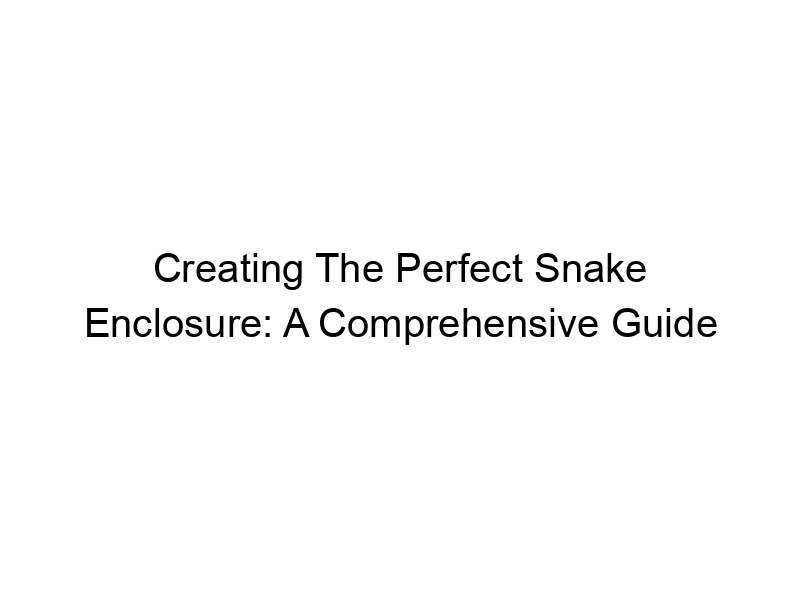Setting up a suitable habitat for your snake is crucial for its health, longevity, and overall well-being. Setting up a snake enclosure requires careful planning and attention to detail, ensuring your reptile thrives in a safe and enriching environment. This comprehensive guide will walk you through every aspect of the process, from choosing the right enclosure to maintaining optimal temperature and humidity levels, covering everything a beginner or experienced snake owner needs to know. We’ll explore various enclosure types, substrate options, necessary equipment, and the importance of enrichment. Let’s dive in!
Before even considering an enclosure, you must identify the specific needs of your snake species. Different snakes have vastly different requirements regarding temperature, humidity, and enclosure size. Researching your snake’s natural habitat is paramount. For example, a desert species like a ball python requires a much drier
environment compared to a rainforest dweller like a green tree python. Ignoring these species-specific needs can lead to illness and even death. Consider consulting reputable herpetological resources and experienced keepers for detailed information on your specific snake.
Choosing the Right Enclosure Type
The type of enclosure you choose depends largely on your snake’s size, arboreal (tree-dwelling) or terrestrial (ground-dwelling) nature, and your budget.
Glass Terrariums
Glass terrariums are popular due to their aesthetic appeal and ease of cleaning. They offer excellent visibility, allowing for easy observation of your snake. However, they can be more prone to temperature fluctuations and require careful monitoring.
PVC Enclosures
PVC enclosures are durable, retain heat better than glass, and are less prone to breakage. They are often preferred for larger snakes or species requiring specific humidity levels. They can be slightly more expensive upfront but offer long-term cost savings.
Wooden Enclosures
Wooden enclosures offer a natural aesthetic and excellent insulation, making them suitable for species that need consistent temperatures and humidity. However, wood can be more challenging to clean and maintain and may be susceptible to damage from moisture.
Substrate Selection: Creating the Right Floor
The substrate you choose plays a crucial role in maintaining humidity and providing a comfortable surface for your snake. Different substrates offer various benefits and drawbacks.
Aspen Shavings
Aspen shavings are a popular and readily available option. They are absorbent, relatively inexpensive, and easy to clean. However, they can be dusty and may not be ideal for all snake species.
Cypress Mulch
Cypress mulch retains moisture well and provides a natural-looking substrate. It’s often favored for species requiring higher humidity levels. However, it can be more expensive than aspen shavings and may require more frequent cleaning.
Paper Towels
Paper towels are a great option for quarantine situations or when cleaning is a priority. They’re easy to change, inexpensive, and prevent the growth of bacteria and fungi. However, they lack the natural feel and texture of other substrates.
Temperature and Humidity Control: Essential for Health
Maintaining the correct temperature and humidity levels is absolutely crucial for your snake’s health and survival. Incorrect temperatures can lead to metabolic problems, while inappropriate humidity can cause respiratory issues or skin problems.
Heating Systems
Several heating systems are available, including heat mats, heat lamps, and ceramic heat emitters. The choice depends on your snake’s specific needs and enclosure type. Always use a reliable thermometer and thermostat to maintain consistent temperatures.
Humidity Control
Humidity levels are controlled through proper ventilation and the addition of water bowls, misting, or humidifiers. A hygrometer is essential for accurately measuring and monitoring humidity levels.
Lighting Considerations: Beyond Just Heat
While heating is crucial, proper lighting is also important. While snakes don’t require the same level of UV light as many reptiles, some species benefit from specific UVB lighting to aid in calcium absorption. Research your specific species to determine its lighting needs.
Water Dishes: Providing Fresh Water
A clean and appropriately sized water dish is essential. The water should be changed daily or as needed to prevent contamination and bacteria growth. The dish should be large enough for your snake to soak in if it chooses.
Hiding Places: Providing Security and Comfort
Snakes are naturally shy creatures and benefit from having hiding places to feel safe and secure. Provide various hides of different sizes and materials, such as caves, cork bark, or half logs. This is especially important for shy species.
Enclosure Size: Ample Space for Growth
The size of your enclosure should be appropriately sized for your snake’s current size and its expected adult size. Overcrowding can lead to stress, while insufficient space can hinder growth and cause behavioral problems. Always ensure your snake has enough room to move, explore, and exhibit natural behaviors.
Decorations and Enrichment: Creating a Stimulating Environment
Beyond the essentials, you can add decorations to create a more enriching and visually stimulating environment. This could include branches, rocks, plants (non-toxic!), or other appropriate items. These additions enhance your snake’s well-being.
Cleaning and Maintenance: Ensuring Hygiene
Regular cleaning and maintenance are crucial for preventing the build-up of bacteria and parasites. Spot clean daily, removing feces and uneaten food. The entire enclosure should undergo a thorough cleaning and disinfection every few months.
Choosing the Right Food and Feeding Schedule: Nutritional Needs
Providing appropriate food and following a correct feeding schedule is fundamental to your snake’s health. Research your snake species’ dietary requirements and ensure you provide appropriately sized and nutritious prey. Overfeeding or underfeeding can be detrimental to their health.
Signs of a Healthy Snake: Recognizing Well-being
Regular observation of your snake is crucial for early detection of illness or stress. Watch for signs of alertness, appropriate shedding, active movement, and good appetite. Any changes in behavior or appearance should be promptly investigated.
Common Mistakes to Avoid: Preventing Problems
Several common mistakes can be made when setting up a snake enclosure, including improper temperature and humidity control, inadequate ventilation, unsuitable substrates, or the lack of hiding places. Being aware of these mistakes can prevent problems and ensure the well-being of your snake.
Dealing with Potential Issues: Handling Problems
Even with meticulous planning, problems may arise. Learn about common health issues, such as infections, parasites, and metabolic bone disease. Having a plan for addressing these issues early can save your snake’s life.
Regular Health Checkups: Prevention is Key
Regular health checkups with a veterinarian specializing in reptiles are recommended. Preventative care is much better than dealing with problems as they arise. This will involve regular examinations and parasite checks.
Frequently Asked Questions
What size enclosure do I need for my snake?
The enclosure size depends on your snake’s species and adult size. A general rule is to provide enough space for the snake to comfortably stretch out. Research your specific species to determine the appropriate enclosure dimensions. For example, a ball python might need a 40-gallon breeder tank, while a corn snake could do well in a 20-gallon long tank.
What type of substrate is best for my snake?
The best substrate depends on your snake’s species and its preferred humidity level. Aspen shavings are a good all-around option, while cypress mulch is better for species that need higher humidity. For easier cleaning, paper towels can be used. Always avoid substrates that are dusty or pose a choking hazard.
How often should I clean my snake’s enclosure?
Spot clean daily, removing waste and uneaten food. Perform a complete deep cleaning and disinfection of the enclosure every few months. The frequency may vary depending on the size of your snake and the type of substrate used.
What kind of lighting do I need for my snake?
Most snakes don’t require UVB lighting, but some species may benefit from it. Research your specific species’ needs. Providing heat is more critical than UVB, which can be determined through a basking spot on a heating lamp or heat mat.
What should I feed my snake?
The diet of your snake depends on its species. Some snakes eat rodents, while others eat insects. Always provide appropriately sized prey items to avoid injury to your snake. Research your specific species’ dietary needs thoroughly before feeding it.
How do I maintain proper humidity levels?
Humidity levels are crucial for your snake’s health and can be controlled with misting, water bowls, or humidifiers. A hygrometer is crucial for monitoring. The exact humidity requirement will vary per species.
My snake isn’t shedding properly, what should I do?
Improper shedding can indicate problems with humidity, temperature, or overall health. Ensure proper humidity levels and assess your enclosure’s temperature. If the problem persists, consult a reptile veterinarian immediately.
Final Thoughts
Setting up a snake enclosure is a rewarding yet responsible undertaking. By carefully considering your snake’s specific needs and following these guidelines, you can create a safe, stimulating, and enriching environment where your snake will thrive. Remember, research is paramount; understand your snake’s species-specific requirements, invest in quality equipment, and monitor their health closely. Consistent monitoring, regular cleaning, and providing an appropriately enriched environment will contribute significantly to your snake’s long-term health and happiness. Remember, regular vet visits are crucial to early detection and prevention of any issues. Now that you’ve learned how to properly set up a snake enclosure, you’re well-equipped to provide your scaly friend with the best possible care. Enjoy the experience of reptile keeping!




